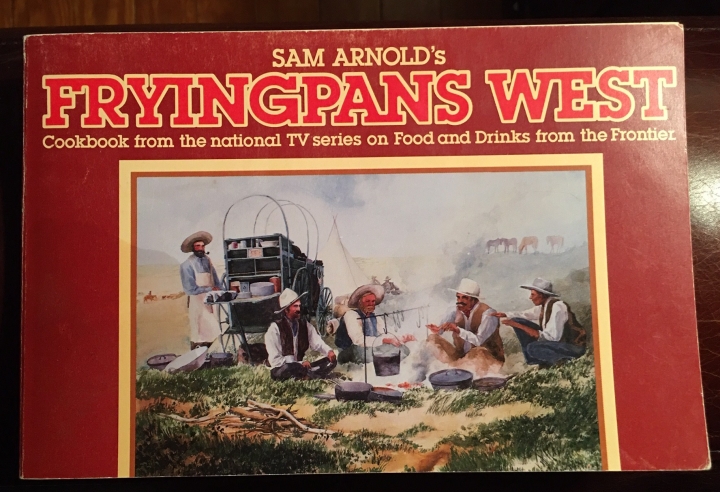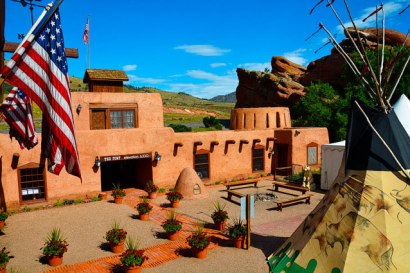My dear friend, Elaine Harmon, often leaves books at my doorstep. She has a true knack for finding the perfect treasure and matching it with a happy new home.
A few weeks ago, she gifted me with a copy of Sam Arnold’s “Fryingpans West.” I’d never heard of the author before, and she said he’d visited Fort Davis years ago and thought I’d enjoy the book. She was so right.

I’m sure many of you know who Sam Arnold was, but I’d never heard of him before Elaine gave me a copy of his book. He was a Western food historian, radio host and gained his foodie popularity beginning in the 1960s. He had a cooking and history show on PBS that featured the foods and drinks of the early West. He featured the foods that the early pioneers brought with them, and the foods that they met on the wagon trail. He even rubbed elbows with Julia Child.
I’ve found some of the episodes of his television show, “Fryingpans West,” on the internet, and what a treat it’s been to watch. Sam shared recipes and methods of how to prepare foods items that the early settlers ate that might seem totally old-fashioned to us now, but we can recreate them using currently available grocery store items.
He demonstrated how to make beef jerky, pemmican, and the proper way to serve beef marrow and salt pork, just like early pioneers made in their cast iron skillets on the trail, back in the early 1800s.
Life in the early forts of the West were more refined than you might think. If you’ve been to the Fort Davis National Historic Site and peeked through the windows of the officer’s homes, you can see the refinement in the furnishings and tablescapes. I imagine the same was true for many other pioneer forts.
Dishes of beaver tail and raw buffalo liver were often the entrée, but it was regularly served on fine porcelain with damask napkins.
Many forts had wine cellars filled with French and Spanish wines, including wine from the Canary Islands, ports, sherries, clarets and the occasional bottle of champagne. Wine was sold by the hogshead or “pipe” (2 hogsheads or 105 gallons) and decanted from the barrels into blown glass bottles that came from the wine supplier. Glass bottles were rare on the frontier.
Adult beverages from the early days often included whiskey, bourbon, with dark rum or cognac reserved for special occasions. Cherry Bounce, a drink made of cherries soaked in brown sugar and rum or cognac, was served at Christmastime. His television shows were not only filled with foods and drink of the olden days, but chock full of history, too.
In his earlier research of the Old West, Sam ran across a photo of a fort, and it struck something deep within. The picture was of Bent’s Fort, the fur trading and freighting center of the Santa Fe Trail. He decided to build a dream home, made from adobe brick, to replicate the old castle-like fort in the picture.


When construction was complete, he found that he was running low on funds and decided to turn part of his home into a restaurant, The Fort, an authentic and nationally-recognized Western cuisine restaurant, open since 1962.
He was recognized as a top authority on foods of the Southwest and early West, including Native American foods, southern foods, New England foods and Mexican foods. He read over 2,000 journal entries of early settlers and found that the main subject they all talked about was meal time. He created many cookbooks, with illustrations by his wife Carrie, who was an artist.
One popular dessert on the frontier in New Mexico was Capirotada, a bread pudding. Back in the olden days, the missions in New Mexico received supplies from Old Mexico by a wagon train that came through about every two years. They received wines, fruit, tree seeds and grape shoots, chocolate, cheeses and delicacies from Europe for the French and Spanish priests.
Capirotada was introduced to the early mountain men and travelers to New Mexico, as early as 1825. Since the travelers and mountain men had trouble with Spanish, they called it, “Spotted Dog” because of the raisins in the bread pudding. Later when chuckwagon cooks made their version of it, they called it “Spotted Pup.”
Sam Arnold died in 2006, but his legacy lives on for those of us that are a little late to discovering him, thanks to his cookbooks and videos. His Denver-area restaurant, The Fort, is still open today, serving Old West dishes in his adobe castle that was inspired by a picture in an old history book.
Capirotada
2 cups toasted bread
4 eggs
2 cups milk
1 cup raisins in hot water
½ pound brown sugar
2 tablespoons cinnamon
1 teaspoon nutmeg
½ onion
½ pound butter, melted
1 cup Longhorn cheese
2 cups sliced apples (optional)
Break up toasted bread, preferably old, dry bread. In another bowl, beat eggs well and add milk. Separately, put raisins in 1 cup hot water to cover. Allow to soak and plump for five minutes, and drain. Add dark-brown sugar to the milk-egg mixture and mix in with sliced apples. Add cinnamon, and nutmeg. Chop onion fine. Mix all thoroughly with the bread and moisten with melted butter. Grate Longhorn cheese. Place layers of the pudding in a casserole, alternately with layers of the cheese. Bake at 350 degrees for about 45 minutes, and serve hot. Sprinkle with tiny, colorful cookie candies and peanuts (note: I’m not too sure the pioneers had colorful sprinkles or peanuts but I didn’t create this recipe, I’m just sharing it).



That Capirotada looks really super yuumy! What an awesome way to use stale bread, at least that’s what my mom says, lol. I use to love this because my mom made the best capirotada ever. I don’t make it because my boys don’t like it. But I should because it’s a recipe that should be passed down. I need to ask her to write it down. But I’m sure this one is about as close to my mom’s that I can think of. But I never thought of using apples, I mean what a great addition!
LikeLiked by 1 person
Did your mom put sprinkles on it? That part makes it so festive but I highly doubt frontier cooks had sprinkles 😂
LikeLike